
Ichneutica mutans, commonly known as the New Zealand cutworm or the grey-brown cutworm, is a moth of the family Noctuidae. This moth endemic to New Zealand and can be found throughout New Zealand, including from Three Kings Islands down to Stewart Island. However this species is not found in the Chatham Islands. The adult moths are on the wing all year round. I. mutans is variable in appearance and can be confused with similar species in the same genus. As a result of the variety of host species consumed by the larvae of the species, including such crops as turnips, wheat and apples, this species is regarded as an agricultural pest. However between the early 1960s and late 1980s the population of I. mutans was shown to have decreased significantly, by over 80%, at two study sites.
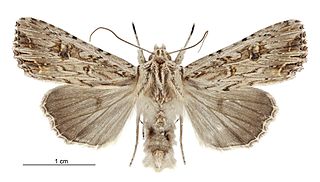
Ichneutica lignana is a moth of the family Noctuidae. It is endemic to New Zealand. This species is found on the Three Kings Islands as well as the North, South and Stewart Islands. This species lives in a variety of habitats including coastal areas, tussock grasslands, shrublands, and native forest, at a range of altitudes from sea level to over 1300 m. I. lignana is quite distinctive in appearance with its dark markings on the abdomen and forewings although it is possible to confuse Ichneutica morosa, Meterana pansicolor and Meterana pascoi with this species. Adults are on the wing throughout the year in the northern parts of the New Zealand but are restricted to the months of October to April in the more southern parts of the country.

Ichneutica insignis is a moth of the family Noctuidae. It is endemic to New Zealand. This species is found throughout New Zealand, although it appears to be scarce in inland sites of tussock grasslands. The adults are on the wing throughout the year. It is a variable species and as such can be easily confused with I. skelloni and I. plena. The larvae of this species have been recorded as feeding on Trifolium pratense.
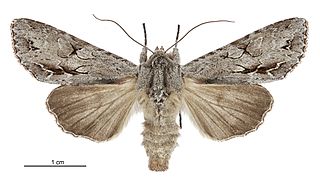
Ichneutica ustistriga is a moth of the family Noctuidae. It is endemic to New Zealand and can be found from the Three Kings Islands to Stewart Island. This species lives in a wide variety of habitats including domestic gardens, horticultural areas, orchards, native and exotic grasslands, as well as native forest. The larvae eat a variety of herbaceous plants. Recorded food plants include Muehlenbeckia australis, Muehlenbeckia complexa, Olearia hectorii, and Plantago lanceolata. This moth has a mauvish grey wing colour and is unlikely to be confused with other species as the patterns on its forewing are distinctive. This species is on the wing throughout the year and is attracted to both sugar and light traps. Adult moths can be found at rest on fences and tree trunks during the day.

Ichneutica semivittata is a moth of the family Noctuidae. It is endemic to New Zealand. It can be found from the Three King Islands down to Stewart Island. The similar species I. sulcana can be distinguished from I. semivittata as the former is much larger, has a darker hindwing and abdomen and has only one to three spots located behind the middle of the forewing in comparison to the 8 or 9 of I. semivittata. This species lives in a variety of habitats from open grasslands to clearings in forest and at a range of altitudes from the sea level to the alpine zone. Larval host species include Juncus procera, Carex secta as well as on tussock grasses such as Poa cita, P. colensoi and Festuca novae-zelandiae. Adults of this species are on the wing from August to April and are attracted to light.

Ichneutica plena is a moth of the family Noctuidae. It is endemic to New Zealand. It is widespread throughout the North, South and Stewart Islands. It is a variable in appearance and therefore can be confused with its near relatives I. peridotea and I. insignis. The larvae of I. plena feed on herbaceous plants including Fuchsia excorticata, Coprosma species, and introduced species such as garden fuchsia as well as crops such as apple trees. Adults of this species are on the wing from late August until May.

Ichneutica olivea is a moth of the family Noctuidae. It is endemic to New Zealand and is found in the central North Island down to the central South Island. It is very similar in appearance to I. lindsayorum but has a shorter basal streak and has white scaling from the subterminal line on the forewings that I. lindsayorum lacks This species prefers shrubland habitat. The life history of I. olivea is unknown as are the host species of its larvae. The adults are on the wing from December to March and are attracted to light.

Ichneutica pagaia is a moth of the family Noctuidae. I. pagaia is endemic to New Zealand and can only be found on the Snares Islands. This species is unlikely to be confused with moths with a similar appearance as it is the only noctuid found in the Snares Islands. Its preferred habitat is tussock grasslands and the hosts for its larvae are likely Poa astonii and Poa tennantiana. Adults of this species are on the wing from November to February.

Ichneutica scutata is a moth of the family Noctuidae. It is endemic to New Zealand. This species can be found in the southern parts of the North Island as well as the eastern parts of the South Island. It is similar in appearance to I. insignis and I. skelloni but can be distinguished as I. scutata is much paler in appearance. It is likely this species inhabits lowland tussock grasslands as well as coastal dunes although it is not common in inland tussock grasslands. The larvae feed on a variety of herbaceous plants such as Plantago and Convolvulus species, Plagianthus divaricatus. It pupates on soil near its host plants. The adults are on the wing from late March to July.

Ichneutica atristriga is a moth of the family Noctuidae. It is endemic to New Zealand and is found through out the North, South and Stewart Islands. The larval hosts likely include tussock grasses included Poa cita, P. colensoi and Festuca novae-zelandiae. Larvae have been reared on species in the genera Bromus and Festuca. The adults of this species are on the wing from November to May. I. atristriga can possibly be confused with the smaller species I. propria. However I. atristriga has thorax and forewings that have a pinkish tinge and I. propria has a dark streak on the discal part of the forewing which I. atristriga lacks. A study has indicated that the population numbers of this species have decreased.

Ichneutica blenheimensis is a species of moth in the family Noctuidae. It is endemic to New Zealand and is found throughout the North, South and the Stewart Islands. This species appears to prefer drier eastern localities and is rarely collected in western North Island forested areas. It does not appear to be frequently collected in inland dry tussock grassland habitats. The host plant for the larvae of this species is likely to be the golden sand sedge pīngao which is now absent from the moths type locality. However Chappell has raised very young larvae on grass species and the more developed larvae consumed Phormium tenax. Adults are on the wing from November to March and are attracted to both light and sugar traps. The blackish forewing fringes are diagnostic of this species. But worn specimens of I. arotis can be confused with worn specimens of I. blenheimensis. However I. arotis can be distinguished from I. blenheimensis as it has a scale-tuft on the thorax and dark longitudinal stripes on the tegula. This species is classified as "At Risk, Naturally Uncommon" by the Department of Conservation.
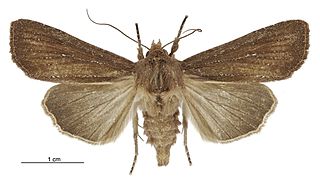
Ichneutica micrastra is a moth of the family Noctuidae. It is endemic to New Zealand. This species has been found only in the North Island and has been collected in the Northland, Auckland, Whanganui and Wellington regions. The preferred habitat of this species is wetlands and heathlands including gum fields in Northland. Adults of this species are on the wing from October to December. The life history of this species is unknown as are the host species of its larvae however it has been hypothesised that the likely larval host is a grass or grass like plant. This species is very similar in appearance to I. phaula and I. sapiens but can be distinguished as a result of differences in male antennae, the shape, colour and size of forewings, the range of the species as well as differences in genital shape.

Ichneutica propria is a moth of the family Noctuidae. It is endemic to New Zealand. This species is only known from Tongariro National Park and Pureora Forest in the North Island but is widespread in the South Island. I. propria might be confused with faded I. atristriga, however the later species lacks the distinctive marking on the prothorax nor does it have the black mark running through the middle of the forewing. It is very common and widespread in montane to alpine grassland areas. Although the larvae have yet to be described, they have been reared on Poa cita and Festuca novae-zelandiae and are known to feed on introduced grass species. The adults of this species are on the wing from December to mid May and are attracted to light.

Ichneutica averilla is a moth of the family Noctuidae. It is endemic to New Zealand. This species is found in the North Island at Mount Taranaki but is widespread throughout the South Island and Stewart Island. It prefers mountainous habitat but can be found down to sea level in the southern parts of the South Island. Adults of the species are on the wing between November and March. Larvae likely exist on a variety of herbaceous plants but have been recorded as feeding on species within the genus Plantago. This species is sometimes confused with I. mutas but can be distinguished from the latter on the basis of forewing colour as well as the absence of or an indistinct antemedian forewing line.

Ichneutica cuneata is a moth in the family Noctuidae. It is endemic to New Zealand. I. cuneata is found in and around the Tongariro National Park in the North Island and throughout the South Island. Specimens found in Tongariro National Park tend to be darker in appearance than South Island specimens but as their colour is variable, and antennae and genitalia of both species are consistent, they are not now regarded as a separate species. I. cuneata inhabits tussock grasslands and shrublands in alpine and subalpine zones. The adults are on the wing from December to April and can be found flying during the day. The life history of I. cuneata is unknown as are the specific host species of its larvae. However larvae of I. cuneata are said to feed on herbaceous plants. The adults of this species also pollinate native species such as Myosotis macrantha.

Ichneutica disjungens is a moth of the family Noctuidae. This species is endemic to New Zealand and can be found on the central volcanic plateau of the North Island and in the eastern as well as the south western parts of the South Island. I. disjungens inhabits tussock grasslands in the alpine and subalpine zones. The hosts of the larvae of this species include Poa cita, P. colensoi, and Festuca novae-zelandiae. The adults of this species are distinctive and are unlikely to be confused with other species. They are on the wing between October and March.

Ichneutica erebia is a moth of the family Noctuidae. This species is endemic to New Zealand and is found on Campbell Island and the Auckland Islands. Adults of this species are on the wing from August to January. The adults are variable in appearance but can be distinguished from similar species by the patters or lack thereof on their forewings. The larvae of I. erebia are polyphagous and hosts include Pleurophyllum criniferum, species within the genera Stilbocarpa and Carex, as well as Chionochloa antarctica, Urtica australis and Raukaua simplex.
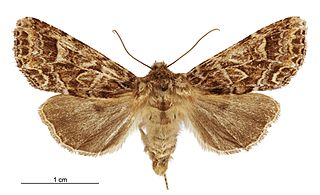
Ichneutica brunneosa is a moth of the family Noctuidae. This species is endemic to New Zealand. It can be found in the North Island from Mount Te Aroha and in the South Island from the Coromandel to Stewart Island. However it appears to not be present in the centre of the South Island. The distinctive colour and patterns on the forewing of this species ensures it is unlikely to be confused with similar species. It inhabits native forests with higher rainfall and is attracted to mercury vapour light traps. The life history of I. brunneosa is unknown as are the host species of its larvae but the adults of the species are on the wing from October to January.
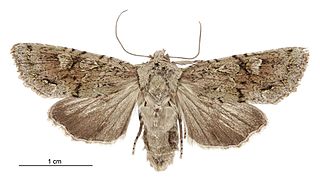
Ichneutica skelloni is a moth of the family Noctuidae. This species is endemic to New Zealand. Its presence has been confirmed in the North Island only in the Wellington region but is widespread throughout the South Island. It is also found in Stewart Island. I. skelloni is extremely variable in size, in the colour and patterns on the fore and hind wings, length of pectinations on male antennae and even in its genitalia. A larger more patterned form can be found in Westland and Fiordland, a medium-sized form is found from Wellington to Stewart Island and there is also a smaller Dunedin and Southland form. This species can be confused with specimens with the species I. insignis, I. scutata and I. pelanodes. I. skelloni can be found in forest and shrubland habitat. Adults are on the wing from July to April and are attracted to light. Host plants for the larvae are found in the genera Plantago, Senecio and Ranunculus and also include the species Bellis perennis.

Ichneutica infensa is a moth of the family Noctuidae. This species is endemic to New Zealand. It is found throughout the North and South Islands but appears to be rarely seen or collected in the north and west parts of the North Island. As at 2019 the northern limit to the range of this species is Titirangi. I. infensa inhabits tussock grasslands and native forest. Larvae are nocturnal and its host plants are in the genus Carex including Carex solandri. Larvae have also been raised on Bromus catharticus. Adults of this species are on the wing from late October to February. Adults are narrow winged with patterns on the forewings that are relatively distinctive. However this species can possibly be confused with I. inscripta.
























